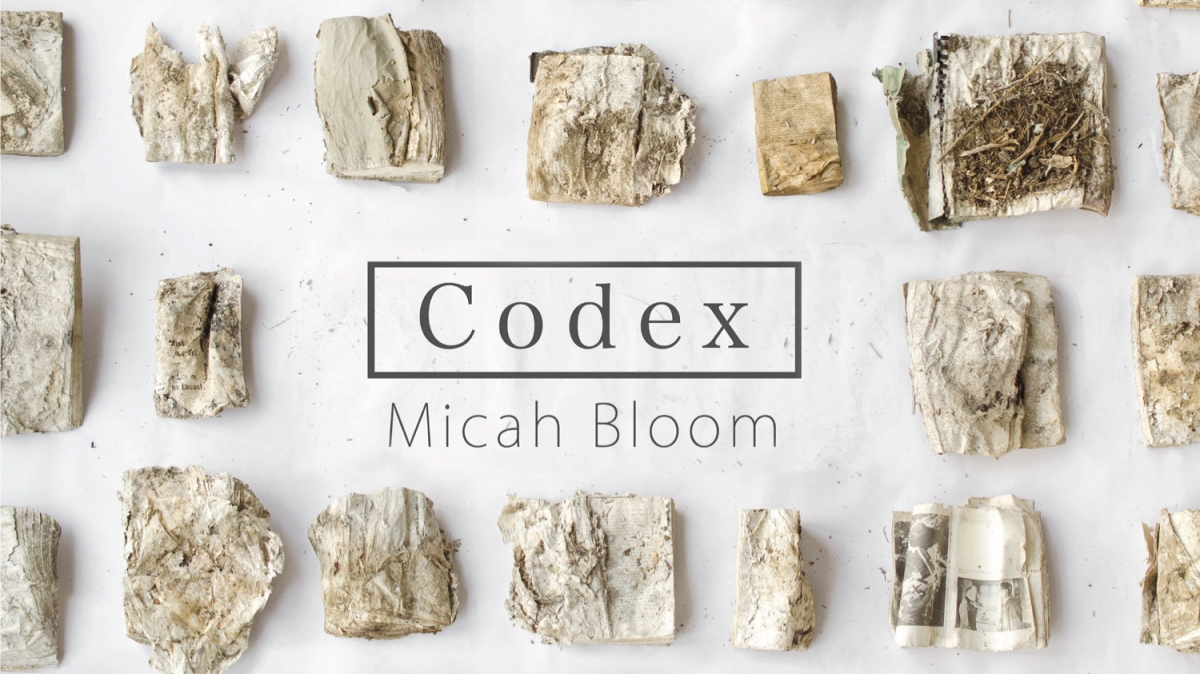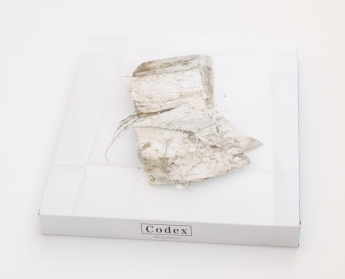
Download or View the Full Version of Codex Here (via Archive.org)
Download the Full Version of Codex Here (pdf)
Micah Bloom, Codex. Grand Forks, ND: The Digital Press at the University of North Dakota, 2017.
https://doi.org/10.31356/dpb001
Watch the Film: CODEX (20 Minute Cut) | CODEX (40 Minute Cut)
Micah Bloom’s Codex examines the fate of books in the aftermath of the 2011 Minot flood. It is an ambitious project that flows across a wide range of media (digital text, video, hardcover, and paperback), embraces archaeological sensibilities, and speaks simultaneously to universal and profoundly local experiences.
The book is available in both an expanded, color digital download and in a trade paperback (coming soon!). Both versions bring together Bloom’s haunting imagines with nine essays exploring our own engagement with physical books, the history of the book, and the events surrounding the 2011 flood in Minot, North Dakota.

From Micah Bloom:
In books lies the soul of the whole Past Time: the articulate audible voice of the Past, when the body and material substance of it has altogether vanished like a dream. ~Thomas Carlyle
When I was a child, my parents instilled in me a reverence and respect for books. Books couldn’t be stepped on, sat on, or abused, because they contained something mysterious and powerful, beyond their mere, physical composition: wood fibers and ink. In a magical way, they were carriers of that which was irreplaceable; they housed an intellect, a unique soul. In our home, books were elevated in the hierarchy of objects; in their nature, deemed closer to humans than furniture, knick knacks, clothing, etc. It was these early sentiments that took hold of me when I first encountered the Codex books.
While riding my bike to work each day, dodging debris from the recent Minot flood (and sometimes not dodging and getting flat tires), I came upon these books: out in the open, exposed to the elements, battered by wind and rain. They hung in the trees and were strewn across the landscape. Because of my upbringing, I couldn’t ignore them, and they pulled me into telling their story: a story of necessity, loss, neglect, obsolescence, progress, privilege, excess, ignorance, and valediction.
I’ve now spent over a year with these books: spring, summer, winter, fall, night, day, wind, rain, dust, snow, dew, nests, eggs, webs, sprouts, sticks, leaves, bulldozers, trains, trucks, duck weed, worms, spiders, birds, muskrats . . .

On Codex:
“At a time in human history when we are oversaturated with digital (mis)information, Micah Bloom’s Codex offers a creative mediation on the materiality of the book, as a unique format of organizing knowledge, that is a balm for the weary imagination.”
– James Romaine, Professor of Art History, Lander University
“Codex carefully unwinds a story that is both tragic and beautiful. There are no simple answers here, yet in the midst of the questions, Bloom returns to one thing, beauty.”
– Nathan Clarke, Fourth Line Films
“More than a book of provocative photos, Codex is a visual exploration, capturing drift at the brink of disintegration. Cheaply made, dispensable, and in countless copies, Micah Bloom captures drifted books in their last and fleeting moments of beauty. Bloom offers a requiem to a fragile medium transitioning into nature.”
– Kostis Kourelis, Associate Professor of Art History, Franklin and Marshall College.
“Codex joins that small collection of books on my desk that I turn to for inspiration. it is a thing of beauty and care, as well crafted as a rocking chair; it is form and function, celebrating knowledge. It is a mathematical mystery in the aftermath of a natural disaster — it is biological and mathematical, made of dirt and water, paper, insects and words. Codex shows how truly beautiful elemental ruin can be when removed from context — it is a grand canyon created when humans and chaos conspired to make art — living art which endures in its decay, changing daily and balanced perfectly on the Pythagorean fulcrum between purely human beauty and purely natural science — Codex is a butterfly’s wings, a sunken ship, an undiscovered cave — you will turn the pages slowly and come back to each one.”
– Kyle Cassidy, Author of This is What a Librarian Looks Like (2016), War Paint: Tattoo Culture & the Armed Forces (2012), and Armed America: Portraits of Gun Owners in their Homes (2007).
The Films
You can download or watch the 20 minute version of the film CODEX here (or below) and the 40 minute version of the film here.
About Micah Bloom
Micah Bloom is an artist and educator, and he lives in Minot, ND, teaching at Minot State University. Bloom holds an MFA in Painting and Drawing from the University of Iowa and has been selected for numerous artist–in–residence fellowships. His works have been published in literary and art journals, and he has shown work nationally and internationally, including private galleries in China and the Shanghai Museum of Contemporary Art. His multi-media project with ooded books, Codex, has been exhibited around the US. Married for 16 years, Micah and his wife Sara, share four daughters and one son, and they all love to make things.
Table of Contents
Preface vii
ALL THE STORIES WE KNOW
ShaunAnne Tangney
Micah Bloom: Codex
Laurel Reuter
Facing Floods: Minot and The Mouse River
Bethany Andreasen
The Flood, the Mill, and the Body of the Book
Thora Brylowe
(De)Composition: or, How Matter Matters
Sheila Liming
Bookish
David Haeselin
Four Parts Water
Justin Sorensen
“Ribbit,” said the Frog
Robert E. Kibler
Books as Bodies
Ryan Stander
Micah Bloom’s Books
Brian Prugh